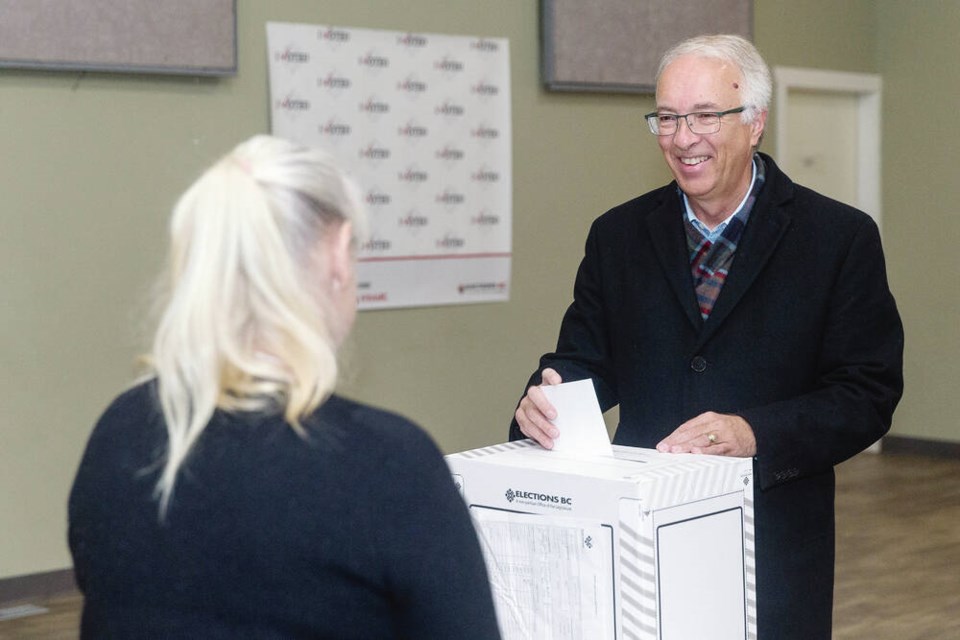BC Conservative Leader John Rustad was reflective when asked this week how he could have gotten his party over the finish line to a 47-seat majority in the provincial election campaign, rather than a 44-seat opposition.
“Well, I think there's an old saying in politics that you don't lose elections, you run out of time,” he said.
Inside the Conservative campaign, time and money proved lacking at key moments.
The Conservatives did not get a $5-million bank loan to fund their campaign until hours after BC United Leader Kevin Falcon announced he was suspending his efforts and throwing his support to the Conservatives on Aug. 28.
It meant a scramble.
Among the things that couldn’t be pulled together in time — one million bifold leaflets with hyperlocal targeted messages about issues like SOGI, forestry and vote splitting — in key ridings like Surrey-Guildford, Surrey City Centre, Vernon-Lumby, and Richmond-Steveston.
The Conservatives lost all those ridings. The leaflets in some cases arrived two days after the Oct. 19 election day.
Would they have made a big difference? Probably not. Though in Surrey-Guildford, where the NDP flipped the riding by 27 votes, who knows. It was an example, though, of a party not being able to get the desired resources to critical areas.
Falcon’s decision to shutter BC United’s election campaign to prevent a centre-right vote split also came too late, said Rustad.
“It would have been great if that could have happened three months earlier,” said Rustad. “That would have given us time to be able to do a bunch of things.”
Three months earlier, though, Falcon was openly mocking Rustad. When Falcon abruptly shuttered his campaign Aug. 28, without consulting his team, some candidates were so angry they decided to run anyway.
The Conservatives had a chance to pick up United candidates — and in many cases, they made the wrong decision not to do so.
In Richmond-Steveston, the Conservatives refused United candidate Jackie Lee. He went on to garner 2,354 votes as an independent, undercutting the less-impressive Conservative candidate Michelle Mollineaux and handing the riding to the NDP’s Kelly Greene by 484 votes.
Same thing in Vernon-Lumby, where United candidate Kevin Acton, the mayor of Lumby, pulled in 4,266 votes, knee-capping Conservative Dennis Giesbrecht and giving the riding to the NDP’s Harwinder Sandhu by 477 votes.
In both cases, the Conservatives could have won had they gone with the United candidate. Or, had Falcon quit earlier and smoothed the way with his caucus, perhaps the Conservative candidate wouldn’t have faced a vote split.
But internal politics, personality conflicts, loyalty and ego prevented common sense from prevailing when it came to Conservative candidate selection.
“There was a lot of people that were dissatisfied (with Falcon’s decision) and wanted to carry on with the fight,” said Rustad. “It's unfortunate.”
The blame for candidate mistakes ultimately lies at the feet of Rustad. So do vetting failures. Even when the party did flag outrageous past social media comments, Rustad wouldn’t fire the person.
The Conservatives could have jettisoned all their problem candidates during the United merger. But Rustad refused, citing loyalty to those who joined the party early. It cost the Conservatives credibility in the long term, leaving a ton of political ammunition on the table for the NDP during the 28-day campaign.
Internally, the Conservatives also scrambled to hire out-of-province help for things like voter identification. They started from scratch on voter ID, whereas the NDP and Greens had lists of supporters from previous elections.
The Conservatives spent $2 million doing mass text message blasts to try and zero in on supporters. But it could only afford to do so for around a month — once Falcon quit and the loan came in.
The Conservatives say they got 80 per cent of the people they identified out to vote. But that accounted for only around half the 910,180 people who voted Conservative. The remaining 400,000 to 500,000 Conservative voters remain a mystery to the party. So while it increased its vote 189 per cent from 2020, it only knows who half of those voters are for the future.
The Conservatives also misjudged their 30 target seats — though, so did the NDP, as both parties wrestled with an angry and shifting electorate.
The Conservatives are currently conducting a post-mortem for their campaign, as well as a new round of polling to see how their advertising efforts landed. It’s likely to conclude this was a winnable election had the party made some different choices.
“The unfortunate part is that we needed perhaps some more time to be able to connect, particularly with those people in the province that may not have heard the messaging and what we were trying to achieve in this province,” said Rustad.
“So we'll be doing some analysis and work on that, and looking at what sort of issues were a barrier for people that did not vote for us in light of, you know, the fact that there could be an election at any time going forward.”
The NDP and Greens are likely to do their own campaign post-mortems. Neither achieved what they set out to accomplish, with the NDP losing 15 incumbents (including five cabinet ministers) and the Greens failing to elect leader Sonia Furstenau in Victoria-Beacon Hill.
The Conservatives had the most to gain, and they did — going from zero MLAs in 2020 to 44 elected this month. But they came up short, when all the ingredients were there to actually win.
Rob Shaw has spent more than 16 years covering B.C. politics, now reporting for CHEK 撸奶社区 and writing for Glacier Media. He is the co-author of the national bestselling book A Matter of Confidence, host of the weekly podcast Political Capital, and a regular guest on CBC Radio.




